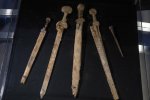Naraku
Draconarius
(It's in Latin, so you may need to use Google and translate)
The article doesn't mention its use as a chamber pot, however, a boat shaped vessel would make sense for a woman anatomically.
There were economic reasons for collecting urine. When urine is allowed to ferment, it develops a high concentration of ammonia and was used in cleaning clothes, dyeing wool and tanning hides until the Industrial Revolution. It was also used to make gunpowder, but the Roman's didn't know about that. Urine was so valuable that Nero imposed a tax on it, the vectigal urinae, which was continued by Vespasian. The modern French, Italian and Romanian words for a urinal are vespasiennes, vespasiani, vespasiene, respectively.

The article doesn't mention its use as a chamber pot, however, a boat shaped vessel would make sense for a woman anatomically.
There were economic reasons for collecting urine. When urine is allowed to ferment, it develops a high concentration of ammonia and was used in cleaning clothes, dyeing wool and tanning hides until the Industrial Revolution. It was also used to make gunpowder, but the Roman's didn't know about that. Urine was so valuable that Nero imposed a tax on it, the vectigal urinae, which was continued by Vespasian. The modern French, Italian and Romanian words for a urinal are vespasiennes, vespasiani, vespasiene, respectively.



















